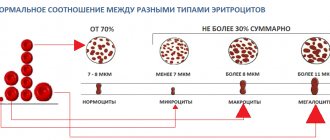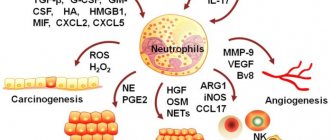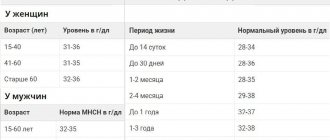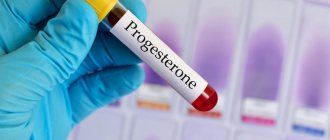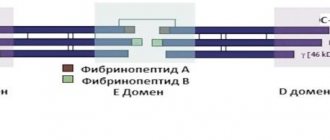7101 02 December
IMPORTANT!
The information in this section cannot be used for self-diagnosis and self-treatment.
In case of pain or other exacerbation of the disease, diagnostic tests should be prescribed only by the attending physician. To make a diagnosis and properly prescribe treatment, you should contact your doctor. We remind you that independent interpretation of the results is unacceptable; the information below is for reference only.
Beta-2-microglobulin (in blood): indications for use, rules for preparing for the test, interpretation of results and normal indicators.
Indications for prescribing the study
Beta-2 microglobulin (Beta-2 microglobulinserum, BMG) is a protein that is found on the surface of almost all cells in the human body.
The study of beta-2-microglobulin in the blood is prescribed for kidney diseases, for patients on dialysis to assess the risk of developing amyloidosis (deposition of pathological proteins in organs and tissues), to identify early signs of kidney rejection after transplantation. Beta-2-microglobulin is often elevated in the blood in cancers such as multiple myeloma (a tumor of the blood cells (lymphocytes) that destroys bones), lymphoma (a tumor that primarily affects the lymph nodes), and leukemia (blood cancer).
Complexes with this research
Female hormones.
Follicular phase Assessment of the hormonal status of a woman in the follicular phase RUB 3,990 Composition Anti-aging diagnostics. Hormonal balance Indicators of aging processes in the female hormonal system RUB 4,490 Composition
Male infertility. Extended examination Analysis of male reproductive health 21,080 ₽ Composition
IN OTHER COMPLEXES
- Advanced male anti-aging diagnostics RUB 25,520
- Male hormones RUB 4,190
- Male anti-aging diagnostics RUB 8,840
Preparation for the procedure
- It is preferable to wait 4 hours after your last meal.
- On the eve of the study, you should avoid food overload (do not eat too much!).
- Avoid drinking alcohol on the eve of the test.
- Do not smoke for at least 1 hour before the test.
- Try not to overexert yourself physically and emotionally on the eve of the test.
- When studying the concentration of beta-2-microglobulin in the blood over time, it is recommended to conduct repeated studies under the same conditions (donate blood in the same laboratory).
Sex hormone binding globulin (SHBG) is a protein produced by the liver that binds to testosterone, dihydrotestosterone (DHT) and estradiol (estrogen) and transports them into the blood in a metabolically inactive form.
Synonyms Russian
Sex steroid-binding globulin, SHBG, SSSG, testosterone-estradiol-binding globulin.
English synonyms
Sex Hormone Binding Globulin, Testosterone, Free Testosterone, Bioavailable Testosterone.
Research method
Electrochemiluminescence analysis.
Determination range: 0.35 - 2000 nmol/l.
Units
Nmol/L (nanomoles per liter).
What biomaterial can be used for research?
Venous blood.
How to properly prepare for research?
- Avoid physical and emotional stress 30 minutes before the test.
- Do not smoke for 30 minutes before the test.
General information about the study
SHBG is a protein produced by the liver. It binds to testosterone, dihydrotestosterone (DHT) and estradiol (estrogen) and transports them into the bloodstream. The content of SHBG in the bloodstream depends on the person’s age, gender, and the intensity of testosterone or estrogen production. In addition, the level of SHBG in the blood is affected by liver disease, hyperthyroidism, hypothyroidism and increased body weight.
The amount of testosterone available for use by body tissues depends on fluctuations in SHBG levels. Under normal conditions, 40% to 60% of testosterone is bound to SHBG, and most of the remainder is weakly bound to albumin. And only about 2% of free testosterone is directly available to tissues.
A test for total testosterone does not distinguish between bound and unbound testosterone - it only determines the amount of the hormone as a whole. In many cases, it is enough to determine the excess or deficiency of hormone production in the body, but if the SHBG indicator deviates from normal, then the detected level of total testosterone is not an accurate reflection of the amount of the hormone available to the body tissues.
Currently, the SHBG test is not used very often - in most cases, tests for total and free testosterone provide enough information.
What is the research used for?
- To determine the status of male hormones (androgens). It is prescribed for men when there is a deficiency of testosterone, for women – when it is in excess. A total testosterone test may be performed along with or before the SHBG test.
- To determine the causes of infertility, decreased sexual activity and erectile dysfunction in men, especially when total testosterone levels are not consistent with the clinical picture.
- For the diagnosis of polycystic ovary syndrome and diseases characterized by excessive androgen production.
- To assess the existing hormone balance - together with tests for free testosterone, albumin, prolactin, estradiol and luteinizing hormone.
- To determine the level of free androgens by calculating their index (ISA) - together with a test for total testosterone. This makes it possible to find out the amount of testosterone not associated with SHBG: ISA = total testosterone / SHBG.
When is the study scheduled?
- If total testosterone test results are inconsistent with clinical observations, such as decreased sexual activity in men and hirsutism in women.
What do the results mean?
Reference values
| Floor | Age | Reference values |
| Female | Less than 1 month | 11.8 - 51 nmol/l |
| 1 month – 1 year | 50 – 181 nmol/l | |
| 1-4 years | 51 – 158 nmol/l | |
| 4-7 years | 48 – 142 nmol/l | |
| 7-10 years | 31 – 103 nmol/l | |
| 10-13 years | 20 - 100 nmol/l | |
| 13-16 years old | 16.6 - 77 nmol/l | |
| 16-20 years old | 9.3 - 75 nmol/l | |
| 20-50 years | 32.4 - 128 nmol/l | |
| More than 50 years | 27.1 - 128 nmol/l | |
| Male | Less than 1 month | 10.8 - 71 nmol/l |
| 1 month – 1 year | 60 – 209 nmol/l | |
| 1-4 years | 42 – 156 nmol/l | |
| 4-7 years | 39 – 146 nmol/l | |
| 7-10 years | 38 – 114 nmol/l | |
| 10-13 years | 32 - 93 nmol/l | |
| 13-16 years old | 13 – 63 nmol/l | |
| 16-20 years old | 10.6 - 54 nmol/l | |
| 20-50 years | 18.3 - 54.1 nmol/l | |
| More than 50 years | 20.6 - 76.7 nmol/l |
When SHBG levels are elevated, it is likely that the free testosterone available to the tissues is much less than the amount shown by the total testosterone test. If the concentration of SHBG is reduced, then testosterone not associated with SHBG is formed more than its total level.
What can influence the result?
- SHBG concentrations can be quite high in children - this is normal.
- SHBG levels in adults are quite stable. In men it rises with age. In postmenopausal women, SHBG concentrations decrease as ovarian hormonal activity decreases.
- Liver disease, hyperthyroidism, and anorexia may contribute to elevated SHBG levels. A decrease in SHBG levels is observed with excess body weight, hypothyroidism, androgen consumption and Itsenko-Cushing's disease.
Reference values:
| Age | Men, mg/l | Women, mg/l |
| 1 day – 4.3 weeks. | 1,6 – 4,8 | 1,7 – 4,5 |
| 4.3 weeks – 6 months | 1,4– 3,3 | 1,0 – 3,8 |
| 6 months – 12 months | 0,9 – 3,1 | 1,0 – 2,3 |
| Over 1 year old | 0,9 – 2,0 | 0,9 – 2,0 |
Beta-2-microglobulin is present on almost all cells of the body and is released into the blood, especially by beta lymphocytes (blood cells that provide immunity, recognize foreign structures, and synthesize antibodies).
In the human body, beta-2-microglobulin performs important functions:
- provides the process of antigenic presentation (presentation) of a foreign agent to trigger an immune response;
- participates in cell proliferation (cell reproduction by division);
- involved in the process of apoptosis (controlled physiological self-destruction of cells);
- regulates the production of hormones and cell growth factors.
Beta-2-microglobulin is used in clinical practice as a tumor marker for patients with blood cancer (when blood cells degenerate into tumor cells and cease to perform their functions).
Blood beta-2-microglobulin concentrations are used to determine the severity and spread of multiple myeloma and lymphoma. A higher level of beta-2-microglobulin in the blood corresponds to a more advanced stage of the oncological process.
Studying the concentration of beta-2-microglobulin in the blood over time allows us to draw conclusions about the effectiveness of treatment:
- an increase in beta-2-microglobulin levels may mean that the cancer is spreading and therapy is not effective;
- a decrease in beta-2-microglobulin levels indicates a good prognosis and effective treatment;
- A decrease and subsequent increase in beta-2-microglobulin levels indicates that the cancer has recurred after treatment.
Beta-2-microglobulin is present in most body fluids, most in the blood, less in the cerebrospinal fluid, and trace amounts in the urine.
In adults, the production of this protein is relatively constant. Beta-2-microglobulin passes through the glomeruli of the kidneys (structures that filter the blood), and then returns to the lower parts (in the kidney tubules). When the glomeruli of the kidneys are damaged, they cannot filter beta-2-microglobulin and its levels in the blood increase. The study of beta-2-microglobulin in patients with kidney disease is prescribed for differential diagnosis in order to determine which parts of the kidney are damaged.
In people with kidney disease who are on dialysis (a procedure to artificially cleanse the blood of toxins and harmful substances), beta-2-microglobulin can form abnormal structures that are deposited in joints and tissues (dialysis-associated amyloidosis). Therefore, for patients who have been on dialysis for more than five years, it is recommended to determine the level of beta-2-microglobulin for early detection of amyloidosis.
Sex hormone binding globulin (SHBG)
What is sex hormone-binding globulin (SHBG)?
This is a blood plasma protein involved in the binding and transport of sex hormones and is produced in the liver. There are many synonyms for this protein in the literature: sex steroid binding globulin, androgen binding globulin, sex steroid binding globulin. It binds sex hormones in the blood: testosterone, 5-dihydrotestosterone, androstenedione, estradiol, progesterone, limiting the amount of the biologically active (unbound) part of each hormone. When the concentration of this globulin decreases, the proportion of hormones freely circulating in the blood increases. In this case, the effects of the hormones are enhanced, although the total concentration of the hormone may not exceed the reference values. In this case, androgenic effects increase more strongly than the effects of estradiol, since the affinity of SHBG for estradiol is higher. Progesterone binds to SHBG so tightly that its biological activity remains virtually unchanged in this situation. Estradiol not only displaces androgens from communication with SHBG, but also increases its synthesis in the liver.
In women in the third trimester of pregnancy, the content of SHBG increases significantly. Androgens inhibit the synthesis of SHBG. After age 60, SHBG levels increase by approximately 1.2% per year. Accordingly, the amount of testosterone associated with it increases. Thus, with age, the level of biologically active testosterone decreases to a greater extent than the level of total testosterone. It has been found that 50% of men aged 50 - 70 years have levels of bioavailable testosterone below the normal level of the hormone for men aged 20 - 40 years. But a high serum concentration of this globulin is a marker of a favorable state of the cardiovascular system.
Indications for the purpose of analysis:
in both sexes:
- clinical signs of increased or decreased androgen levels with normal testosterone levels;
- baldness;
- acne;
- oily seborrhea;
- identification of markers of insulin resistance.
among women:
- hirsutism;
- anovulation;
- amenorrhea;
- polycystic ovary syndrome;
- predicting the development of gestosis.
for men:
- male menopause;
- chronic prostatitis;
- violation of potency;
- decreased libido.
When does an increase in SHBG levels occur?
- Hyperestrogenism;
- Constitutional features;
- Hyperthyroid state;
- Hepatitis;
- HIV infection;
- Taking medications such as oral contraceptives that contain estrogens; phenytoin.
When does a decrease in SHBG levels occur?
- Nephrotic syndrome;
- Major collagenoses;
- Hyperandrogenism;
- Insulin resistance;
- Hypothyroidism;
- Acromegaly;
- Cushing's disease;
- Hyperprolactinemia;
- Polycystic ovary syndrome;
- Adrenogenital syndrome;
- Cirrhosis of the liver;
- Taking medications such as danazol, androgens, glucocorticoids, somatostatin.
Reasons for increased levels of beta-2-microglobulin in the blood:
- inflammatory process in the body;
- autoimmune disorders (including systemic lupus erythematosus, Sjogren's syndrome, rheumatoid arthritis), when the immune system mistakenly attacks its own cells;
- blood cancer - multiple myeloma, B-cell chronic lymphocytic leukemia, non-Hodgkin's lymphoma, Hodgkin's disease;
- viral infections (HIV, cytomegalovirus infection, infectious mononucleosis, etc.);
- renal failure;
- kidney transplant rejection;
- in patients on hemodialysis.
What does exceeding the norm indicate?
| Albumin | Dehydration, shock |
| Alpha 1 globulin | Pathologies of functional liver cells, acute and chronic inflammation, neoplasms, third trimester of gestation, trauma (including surgery), androgen therapy |
| Alpha-2 globulin | Inflammatory processes, tissue death, malignant formations, nephrotic syndrome, liver cirrhosis, COCs and estrogen preparations, pregnancy |
| Beta globulin | Pathologies of immunoglobulin secretion, estrogen therapy, anemia caused by iron deficiency, pregnancy, subhepatic jaundice, multiple myeloma |
| Gamma globulin | Chronic liver diseases, chronic infectious and autoimmune diseases, pathologies of lymphoid cells |
Reasons for the decrease in beta-2-microglobulin in the blood over time:
- effective cancer treatment.
Sources:
- Drueke TB, Massy ZA. Beta2-microglobulin. Semin Dial 2009; 22: 378–380.
- ChanghoonYoo, Dok Hyun Yoon, Cheolwon Suh.Serum beta-2 microglobulin in malignant lymphomas: an old but powerful prognostic factor. Blood Res. – 2014.
- Burtis CA, Bruns DE. Tietz Fundamentals of Clinical Chemistry and Molecular Diagnostics, seventh edition, 2015; 306 p.
- Corlin D, Heegaard N (2012) β2-Microglobulin Amyloidosis. In: Harris J (eds) Protein Aggregation and Fibrillogenesis in Cerebral and Systemic Amyloid Disease. Subcellular Biochemistry, vol 65. Springer, Dordrecht.
- S. Vincent Rajkumar. Myeloma Today: Disease Definitions and Treatment Advances, Am J Hematol. 2021 Jan; 91(1): 90–100.
Immunoglobulin is elevated in an adult - reasons
If immunoglobulin E is elevated, what does this mean? Immunoglobulin E may be elevated in the presence of parasitic infestations - ascariasis, intestinal nematode, echinococcosis, hookworm disease, amoebiasis, helminth larval migration syndrome. Immunoglobulin levels are also elevated in patients suffering from allergic bronchopulmonary aspergillosis. Elevated immunoglobulin in the blood is detected in patients with allergic diseases caused by IgE antibodies:
- atopic bronchial asthma;
- allergic rhinitis and sinusitis;
- atopic dermatitis;
- drug and food allergies.
Total immunoglobulin ig E may be elevated due to anaphylaxis, urticaria, and angioedema. High immunoglobulin in patients suffering from immunopathological diseases:
- IgE myeloma;
- periarteritis nodosa;
- hypereosinophilia syndrome;
- hyper-IgE syndrome;
- recurrent pyoderma;
- pemphigus (Neumann's syndrome).
Immunoglobulin may also be exceeded in the case of graft-versus-host disease.
Albumin, globulins, urea – indicators of protein metabolism
A decrease in the amount of albumin to a level of less than 30 g/l causes edema. Its norm ranges from 35 to 55 g/l. A decrease indicates malnutrition of protein products, toxic liver diseases, colitis, and enteritis. Normally, the albumin content is in the range of 40–60% of the total amount of protein fractions.
The amount of α-globulins is 9–18%, β- and γ-globulins are 8–15 and 12–22%, respectively. An increase in globulins confirms inflammation. An indicator of an acute form of inflammation is C-reactive protein, which, as shown by a biochemical blood test, is not normally found in healthy people.
Blood urea is an indicator of protein metabolism. A biochemical blood test in children shows that normally its level ranges from 1.8 to 6.4 mmol/l, in adults – from 2.1 to 7.1. An increase indicates consumption of high-protein foods, kidney disease, a decrease indicates fasting or a violation of the protein-synthesizing function of the liver.
Cholesterol and lipids
When determining the amount of cholesterol, pay attention to advanced indicators of a biochemical blood test: both the total concentration and the ratio of different lipid fractions. The norm is considered to be within the range of 3.6–5.2 mmol/l; an increase is recorded when it is above 6.5. Cholesterol consists of HDL and LDL (high and low density lipids).
If VLDL (very low density lipids) and chylomicrons predominate, this indicates vascular congestion, atherosclerosis, and hypertension.
An additional indicator for diagnosing coronary artery disease and atherosclerosis (using biochemical blood test data in adults) is the amount of triglycerides. Their norm is 1.7–2.25 mmol/l, the highest level starts at 2.26.
Evaluation of patients with high immunoglobulin B levels
If a patient has a very high level of immunoglobulin E in the blood, this is not enough to diagnose an allergy. To search for the allergen that caused the disease, doctors at the Yusupov Hospital identify specific antibodies of the immunoglobulin E class. Currently, laboratory technicians determine allergen-specific immunoglobulin E in serum for six hundred allergens that most often cause allergic reactions in humans.
If specific immunoglobulin E to any antigen or allergen is detected in the blood serum, this is not conclusive evidence that this particular allergen is responsible for the clinical symptoms. Allergists at the Yusupov Hospital interpret research results only after comparing them with the clinical picture of the disease and a detailed allergological history. The absence of specific immunoglobulin E in the blood serum does not exclude the possibility that an IgE-dependent mechanism is involved in the development of the disease, since local production of immunoglobulin E and sensitization of mast cells can occur in the absence of specific immunoglobulin E in the blood. This happens with allergic rhinitis. Antibodies of other classes that are specific for a given allergen may cause false negative results.
